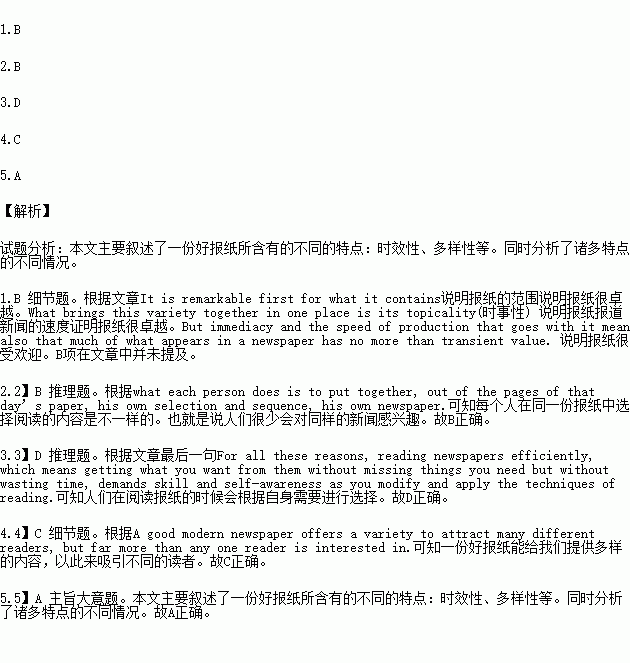题目内容
A good modern newspaper is an extraordinary piece of reading. It is remarkable first for what it contains: the range of news from local crime to international politics, from sports to business to fashion to science, and the range of comment and special features as well, from editorial page to feature articles and interviews to criticism of books, art, theatre, and music. A newspaper is even more remarkable for the way one reads it: never completely, never straight through, but always by jumping from here to there, in and out, glancing at one piece, reading another article all the way through, reading just a few paragraphs of the next. A good modern newspaper offers a variety to attract many different readers, but far more than any one reader is interested in. What brings this variety together in one place is its topicality(时事性) , its immediate relation to what is happening in your world and your locality now. But immediacy and the speed of production that goes with it mean also that much of what appears in a newspaper has no more than transient value. For all these reasons, no two people really read the same paper: what each person does is to put together, out of the pages of that day’s paper, his own selection and sequence, his own newspaper. For all these reasons, reading newspapers efficiently, which means getting what you want from them without missing things you need but without wasting time, demands skill and self-awareness as you modify and apply the techniques of reading.
1. A modern newspaper is remarkable for all the following except its ________.
A. popularity B. uniform style
C. wide coverage D.speed in reporting news
2.According to the passage, the reason why no two people really read the “same” newspaper is that __________.
A. people have different views about what a good newspaper is
B. people are rarely interested in the same kind of news
C.people scan for the news they are interested in
D. different people prefer different newspapers
3. It can be concluded from the passage that newspaper readers _________.
A. apply reading techniques skillfully
B. jump from one newspaper to another
C. appreciate the variety of a newspaper
D. read a newspaper selectively usually
4. A good newspaper offers “a variety” to readers because __________.
A. it has to cover things that happen in a certain locality
B. readers like to read different newspapers
C.it tries to serve different readers
D. readers are difficult to please
5. The best title for this passage would be “__________”.
A. The Characteristics of a Good Newspaper
B. The Variety of a Good Newspaper
C. The Importance of Newspaper Topicality
D. Some Suggestions on How to Read a Newspaper

